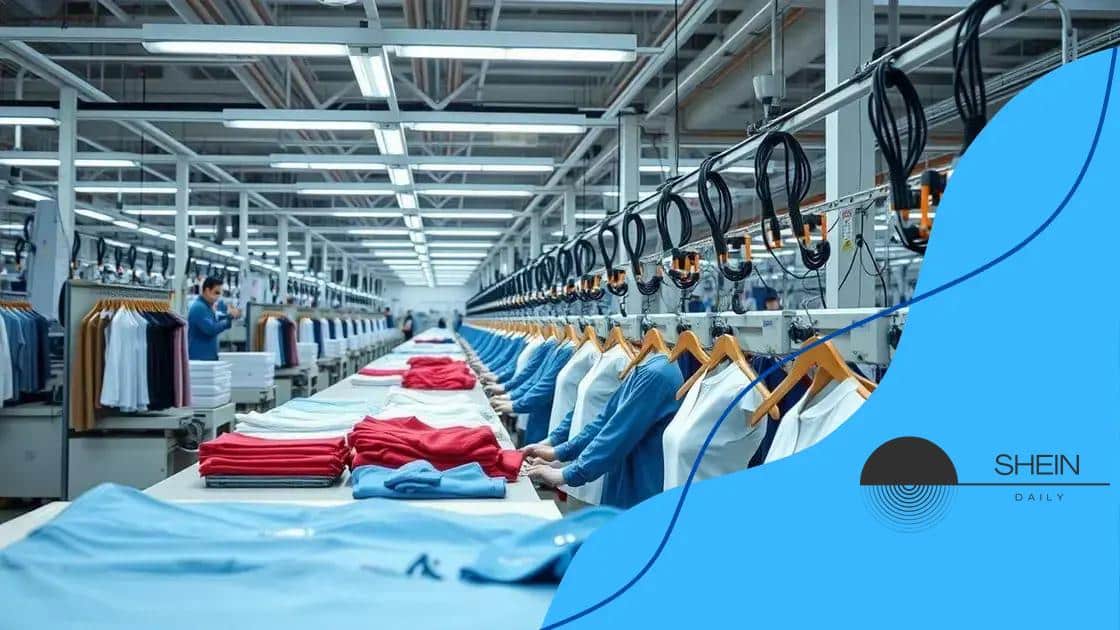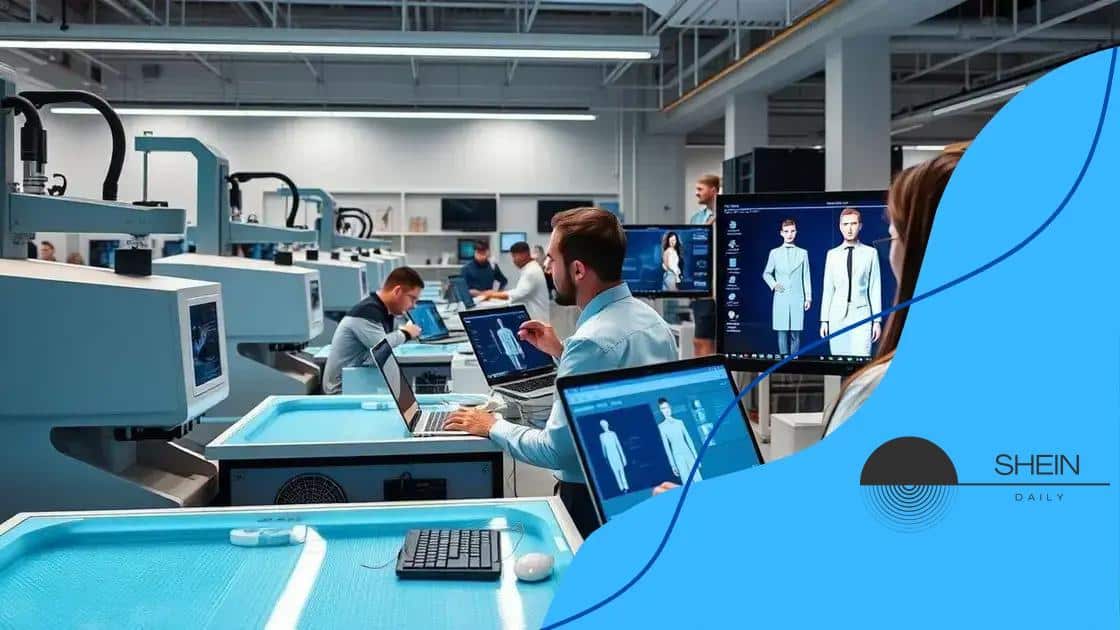Shein’s approach to managing supply chain costs effectively

Shein’s approach to managing supply chain costs involves leveraging data analytics, adopting agile production methods, and implementing sustainable practices to enhance efficiency and respond rapidly to consumer trends.
Shein’s approach to managing supply chain costs showcases innovative strategies that are shaping the fashion landscape. Have you ever wondered how they keep prices low while delivering trendy styles? Let’s dive into this intriguing subject.
Understanding Shein’s business model
Understanding Shein’s business model is key to grasping how the company thrives in the competitive fashion industry. By focusing on affordability and speed, Shein has transformed the way consumers shop for trendy clothing. Their unique approach allows them to keep prices low while maintaining a vast selection of fashionable items.
Key Features of Shein’s Business Model
One of the standout aspects is Shein’s agile supply chain. This means they can respond to consumer trends almost in real-time. They gather data on what styles customers are searching for, enabling them to design and produce clothes quickly. This minimal waiting time sets them apart from traditional retailers.
- Data-driven decision making
- Rapid design and production cycles
- Direct-to-consumer sales model
- Global reach through online platforms
Additionally, Shein’s robust online presence allows them to engage directly with their audience. Social media plays a significant role in their marketing strategy. The company uses platforms like Instagram and TikTok to showcase their products and connect with influencers. This approach helps create a buzz around new releases and keeps them at the forefront of fashion conversations.
Customer Engagement Techniques
Furthermore, Shein employs various customer engagement techniques to enhance loyalty and repeat purchases. They frequently offer discounts and promotions, enticing customers to return. Customer feedback also shapes inventory decisions, ensuring that popular items remain available.
Their user-friendly app makes shopping seamless, featuring personalized recommendations based on previous purchases and browsing history. This level of customization enhances the shopping experience, encouraging more purchases.
Through these methods, Shein effectively builds a community around its brand, turning casual shoppers into dedicated customers. Overall, understanding Shein’s business model reveals how innovation in supply chain management, customer engagement, and data utilization drives its success in an ever-evolving marketplace.
Key strategies for cost management
Shein employs several key strategies for cost management that help maintain low prices while maximizing efficiency. Understanding these strategies can offer valuable insights for those in the retail industry.
Data-Driven Insights
One cornerstone of Shein’s approach is its reliance on data analytics. By analyzing customer behavior and market trends, they can make informed decisions about what products to design and how to price them. This approach significantly reduces waste and ensures that the inventory aligns with consumer demand.
- Monitoring sales performance
- Identifying popular styles quickly
- Adjusting production based on real-time data
- Minimizing excess stock
Another important strategy involves efficient sourcing of materials. Shein works closely with suppliers to negotiate better prices, ensuring that production costs remain low. This collaborative approach enables them to secure high-quality materials at competitive rates.
Rapid Production Cycles
Shein is also known for its quick turnaround times. Their production process is designed to be as fast as possible. By utilizing a model known as “fast fashion,” Shein can take a design from concept to consumer in a matter of weeks, compared to the months it typically takes in traditional retail. This agility helps to keep inventory fresh and aligned with current trends.
Furthermore, the company adopts direct shipping methods to minimize costs. By shipping products directly from manufacturers to consumers, Shein cuts out middlemen, resulting in lower expenses. This direct-to-consumer model not only lowers prices but also speeds up delivery times.
Finally, Shein uses targeted marketing practices to optimize their advertising costs. Rather than spending on broad campaigns, they focus on social media and influencer partnerships that reach their core audience. This strategy ensures that marketing budgets are spent effectively, maximizing return on investment.
The impact of technology on efficiency

The impact of technology on efficiency in Shein’s supply chain is profound. By incorporating advanced technologies into their operations, Shein enhances every aspect of the production process, allowing for faster response times and better quality control.
Automation in Production
One of the main ways technology boosts efficiency is through automation. Automating certain aspects of production means tasks can be completed faster and with fewer errors. By using machines for repetitive tasks, Shein can focus human resources on creative processes and quality assurance.
- Improved speed in manufacturing
- Consistency in product quality
- Reduction in labor costs
- Better inventory management
Shein also utilizes technology for data analysis. Tracking customer preferences and inventory levels in real-time allows the company to make informed decisions quickly. This immediate access to valuable data ensures that products align with market demand.
Intelligent Supply Chain Management
Another significant aspect is Shein’s use of AI and machine learning. These technologies analyze patterns in customer behavior and predict future trends. This predictive capability means that Shein can adjust its production schedules accordingly, minimizing excess inventory and reducing waste.
Furthermore, technology enhances the company’s communication with suppliers. With digital platforms, Shein can coordinate operations seamlessly, ensuring that materials are delivered on time. This smooth communication streamlines the entire production cycle, contributing to overall efficiency.
In addition, Shein employs virtual fitting technology to enhance the shopping experience. By allowing customers to see how garments fit before purchasing, they reduce the rate of returns. This feature not only increases customer satisfaction but also saves costs associated with processing returns.
Sustainable practices in supply chain management
Sustainable practices in supply chain management are becoming increasingly important, and Shein is taking significant steps toward being more environmentally friendly. By integrating sustainability into their operations, Shein not only helps the planet but also appeals to a growing base of eco-conscious consumers.
Ethical Sourcing
One major aspect of Shein’s sustainability efforts is ethical sourcing. This means they are ensuring the materials used in their products are obtained responsibly. By partnering with suppliers who follow fair labor practices, Shein supports both the environment and the workers involved in the production process.
- Using organic materials when available
- Supporting fair trade practices
- Reducing environmental impact of production
- Encouraging transparency in sourcing
Additionally, Shein has implemented sustainable manufacturing techniques. These techniques focus on minimizing waste and lowering emissions throughout the production process. By refining their methods, they can create fashionable items while also being gentle on the earth.
Recycling and Circular Economy
Another important practice is Shein’s commitment to a circular economy. This approach encourages recycling and reusing materials whenever possible. Shein promotes recycling programs, inviting customers to return items for reuse or recycling. This not only helps reduce waste but also fosters a culture of responsibility among consumers.
Furthermore, Shein utilizes technology to enhance their sustainability efforts. By analyzing data on product life cycles, they identify areas for improvement and develop strategies to reduce their overall carbon footprint. This data-driven approach supports their commitment to environmental stewardship.
In addition to these practices, Shein is working towards transparency in their supply chain. By sharing information about their suppliers and production processes, they build trust with consumers who prioritize sustainability. This level of openness is vital for fostering a more sustainable fashion industry.
Lessons for other retailers
Lessons from Shein’s approach to managing supply chain costs can provide valuable insights for other retailers navigating a competitive landscape. By understanding Shein’s strategies, businesses can enhance their own operations and improve profitability.
Embrace Data Analytics
One of the first lessons is the importance of data analytics. Retailers can greatly benefit from tracking customer behavior and inventory levels. Analyzing this data allows brands to make informed decisions, optimizing product offerings and reducing excess inventory. Companies should invest in tools that provide real-time insights to stay responsive to market demands.
- Implement data tracking systems
- Regularly analyze consumer trends
- Adjust inventory based on insights
- Use data to predict future needs
Another key takeaway is the necessity of adopting agility in production. Fast fashion brands like Shein excel by shortening production cycles. Retailers can explore partnerships and technologies that enhance responsiveness, allowing them to bring products to market faster.
Focus on Sustainable Practices
Sustainability is an essential consideration. Shein showcases how integrating sustainable practices can enhance brand loyalty. Retailers should prioritize ethical sourcing and waste reduction. Customers increasingly prefer brands that demonstrate environmental responsibility.
Incorporating features such as recycling programs and transparent supply chains can foster trust and engagement with consumers. By promoting eco-friendly practices, retailers can build stronger relationships with their customer base.
Lastly, retailers should leverage innovative marketing strategies. Shein’s direct engagement with customers through social media highlights the need for personalized marketing approaches. Brands can utilize influencer partnerships and targeted advertising to reach specific demographics effectively, increasing brand visibility and loyalty.
In conclusion, Shein’s approach to managing supply chain costs offers valuable lessons for retailers. By leveraging data analytics, brands can optimize inventory and respond quickly to trends. Emphasizing sustainability not only supports the environment but also attracts eco-conscious consumers. Moreover, adopting agile production methods can enhance efficiency and speed. Lastly, innovative marketing strategies allow retailers to connect directly with customers, building trust and loyalty. By following these strategies, other retailers can improve their operations, creating a more sustainable and customer-focused business model.
FAQ – Frequently Asked Questions about Shein’s Supply Chain Management
What are the main strategies Shein uses to manage supply chain costs?
Shein employs data analytics, agile production methods, sustainability practices, and innovative marketing strategies to manage supply chain costs effectively.
How does data analytics benefit retailers like Shein?
Data analytics helps retailers track customer preferences and inventory levels, allowing them to make informed decisions and respond quickly to market demands.
What sustainable practices does Shein implement?
Shein focuses on ethical sourcing, uses sustainable manufacturing techniques, and encourages recycling through customer programs.
Why is fast production important for a retail brand?
Fast production allows brands like Shein to keep up with rapidly changing fashion trends, minimize excess inventory, and enhance operational efficiency.





